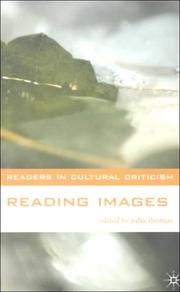| Listing 1 - 10 of 41 | << page >> |
Sort by
|

ISBN: 0333765397 Year: 2001 Publisher: Hampshire Palgrave
Abstract | Keywords | Export | Availability | Bookmark
 Loading...
Loading...Choose an application
- Reference Manager
- EndNote
- RefWorks (Direct export to RefWorks)
#KVHA:Literaire kritiek Engels --- art criticism --- kunstbeschouwing --- Philosophy and psychology of culture --- Kunsttheorie ; kunstbeschouwing --- Popmuziek ; Michael Jackson ; Thriller ; analyse --- Esthetische aantrekkingskracht ; de look ; bij vrouwen --- Fotografie ; theorie ; Susan Sontag --- Fotografie ; theorie ; R. Barthes --- Kunsttheorie ; kunstfilosofie ; Walter Benjamin --- Kunstfilosofie ; Michel Foucault ; panopticisme --- Kunsttheorie ; visuele waarneming ; semiologie --- Film ; filmtheorie ; filmanalyse --- Filmanalyse ; de vrouw in de film --- Visuele waarneming ; door zwarte vrouwen --- Visuele waarneming ; J. Lacan --- Visuele waarneming ; pornografie ; nostalgie ; montage --- Bellini, Giovanni ; moederschap --- Over de boeken ; van P. Eisenman ; door J. Derrida --- Velasquez, Diego ; M. Foucault over Las Meninas --- Estetische illusie ; virtuele realiteit ; J. Baudrillard --- Kunst ; theorie, filosofie, esthetica --- Gaze. --- Image (Philosophy). --- Vision. --- Gaze --- Image (Philosophy) --- Vision --- 7.01 --- Perspectief --- Eyesight --- Seeing --- Sight --- Senses and sensation --- Blindfolds --- Eye --- Physiological optics --- Philosophy --- Visual perception --- #KVHA:Literaire kritiek; Engels --- Image (philosophie)
Book
ISBN: 3319581481 3319581473 Year: 2017 Publisher: Cham : Springer International Publishing : Imprint: Palgrave Macmillan,
Abstract | Keywords | Export | Availability | Bookmark
 Loading...
Loading...Choose an application
- Reference Manager
- EndNote
- RefWorks (Direct export to RefWorks)
This book brings the study of nineteenth-century illustrations into the digital age. The key issues discussed include the difficulties of making illustrations visible online, the mechanisms for searching the content of illustrations, and the politics of crowdsourced image tagging. Analyzing a range of online resources, the book offers a conceptual and critical model for engaging with and understanding nineteenth-century illustration through its interplay with the digital. In its exploration of the intersections between historic illustrations and the digital, the book is of interest to those working in illustration studies, digital humanities, word and image, nineteenth-century studies, and visual culture.
Word Manager (Computer system) --- Computational linguistics --- Grammar, Comparative and general --- Morphology --- Data processing --- Technology in literature. --- Literature, Modern-19th century. --- Literature and Technology/Media. --- Nineteenth-Century Literature. --- Literature, Modern—19th century. --- Literature and technology. --- Mass media and literature. --- Literature, Modern --- Literature and Technology. --- Literature --- Literature and mass media --- Industry and literature --- Technology and literature --- Technology --- 19th century.
Book
ISBN: 9780812244236 Year: 2015 Publisher: Philadelphia University of Pennsylvania press
Abstract | Keywords | Export | Availability | Bookmark
 Loading...
Loading...Choose an application
- Reference Manager
- EndNote
- RefWorks (Direct export to RefWorks)
Shakespeare, William, --- Šekspir, Vil'jam --- Birthplace. --- Homes and haunts --- Stratford-upon-Avon (England) --- Stretford upon Auen (England) --- Stratford (Warwickshire, England) --- Stratford-upon-Avon (Warwickshire) --- Stratford-on-Avon (England) --- Description and travel. --- Shakespeare, William --- Shakespear, William, --- Shakspeare, William, --- Šekʻspiri, Uiliam, --- Saixpēr, Gouilliam, --- Shakspere, William, --- Shikisbīr, Wilyam, --- Szekspir, Wiliam, --- Šekspyras, --- Shekspir, Vilʹi︠a︡m, --- Šekspir, Viljem, --- Tsikinya-chaka, --- Sha-shih-pi-ya, --- Shashibiya, --- Sheḳspir, Ṿilyam, --- Shaḳspir, Ṿilyam, --- Syeiksŭpʻio, --- Shekspir, V. --- Szekspir, William, --- Shakespeare, Guglielmo, --- Shake-speare, William, --- Sha-ō, --- Şekspir, --- Shekspir, Uiliam, --- Shekspir, U. --- Šekspir, Vilijam, --- Ṣēkspiyar, Viliyam, --- Shakspir, --- Shekspyr, Vyli︠e︡m, --- Şekspir, Velyam, --- Ṣēkspiyar, Villiyam, --- Shēkʻspʻiyr, Vlilliam, --- Ṣēkspiyar, --- Ṣēkspiyar Mahākavi, --- Ṣēkspiyar Mahākaviya, --- Sheḳspier, Ṿilyam, --- Shēkʻspir, --- Shakespeare, --- Śeksper, --- Шекспир, Вильям, --- Шекспир, Уильям, --- שייקספיר, וויליאם, --- שייקספיר, וו., --- שיקספיר, וויליאם --- שיקספיר, ויליאם --- שיקספיר, ויליאם, --- שכספיר, ויליאם, --- שכספיר, וילים, --- שכספיר, ו׳ --- שעפקספיר, וויליאם, --- שעקספיער, וויליאם --- שעקספיער, וויליאם, --- שעקספיער, ווילליאם --- שעקספיער, וו., --- שעקספיר --- שעקספיר, וו --- שעקספיר, וויליאם, --- שעקספיר, וויליאמ --- שעקספיר, ווילליאם --- שעקספיר, ווילליאם, --- שעקספיר, וו., --- שעקספיר, װיליאם, --- שעקספיר, װילליאם, --- שעקספיר, װ., --- שעקספער --- שעקספער, וויליאמ --- שקספיר --- שקספיר, וו --- שקספיר, וויליאם --- שקספיר, וויליאם, --- שקספיר, ווילים, --- שקספיר, וילאם --- שקספיר, ויליאם --- שקספיר, ויליאם, --- שקספיר, ויליים, --- שקספיר, וילים --- שקספיר, וילים, --- شاكسبير، وليم --- شاكسپير، وليم --- شكسبير، وليام --- شكسبير، وليم --- شكسبير، وليم، --- شكسبير، و. --- شكسپير، وليم --- شكسپير، ويليام --- شيكسبير، وليام --- شيكسبير، وليام.، --- شيكسبير، وليم --- شکسبير، وليم --- وليم شکسبير --- 沙士北亞威廉姆, --- 沙士比亞威廉姆, --- 莎士比亞威廉姆, --- 莎士比亞威廉, --- 莎士比亞,
Digital
ISBN: 9783319581484 Year: 2017 Publisher: Cham Springer International Publishing :Imprint: Palgrave Macmillan
Abstract | Keywords | Export | Availability | Bookmark
 Loading...
Loading...Choose an application
- Reference Manager
- EndNote
- RefWorks (Direct export to RefWorks)
This book brings the study of nineteenth-century illustrations into the digital age. The key issues discussed include the difficulties of making illustrations visible online, the mechanisms for searching the content of illustrations, and the politics of crowdsourced image tagging. Analyzing a range of online resources, the book offers a conceptual and critical model for engaging with and understanding nineteenth-century illustration through its interplay with the digital. In its exploration of the intersections between historic illustrations and the digital, the book is of interest to those working in illustration studies, digital humanities, word and image, nineteenth-century studies, and visual culture.
Engineering sciences. Technology --- Mass communications --- Literature --- communicatie --- literatuur --- anno 1800-1899 --- anno 1900-1999

ISBN: 1854373188 Year: 2000 Publisher: London Tate Publishing
Abstract | Keywords | Export | Availability | Bookmark
 Loading...
Loading...Choose an application
- Reference Manager
- EndNote
- RefWorks (Direct export to RefWorks)
Book
ISBN: 0821415913 Year: 2004 Publisher: Athens Ohio Univ. Press
Abstract | Keywords | Export | Availability | Bookmark
 Loading...
Loading...Choose an application
- Reference Manager
- EndNote
- RefWorks (Direct export to RefWorks)
Illustration of books, Victorian --- Illustration of books --- National characteristics in art --- History
Book
ISBN: 9780812206623 Year: 2012 Publisher: Philadelphia
Abstract | Keywords | Export | Availability | Bookmark
 Loading...
Loading...Choose an application
- Reference Manager
- EndNote
- RefWorks (Direct export to RefWorks)

ISBN: 0335207901 0335207898 Year: 2001 Publisher: Buckingham [England] ; Phildelphia : Open University Press,
Abstract | Keywords | Export | Availability | Bookmark
 Loading...
Loading...Choose an application
- Reference Manager
- EndNote
- RefWorks (Direct export to RefWorks)
Universities and colleges --- Universités --- Public relations --- Relations publiques --- Public relations. --- Universités

ISBN: 1282356380 0520926846 9786612356384 1597348546 9780520926844 0585468575 9780585468570 9781282356382 9780520228542 0520228545 9781597348546 0520228545 Year: 2001 Publisher: Berkeley, Calif. University of California Press
Abstract | Keywords | Export | Availability | Bookmark
 Loading...
Loading...Choose an application
- Reference Manager
- EndNote
- RefWorks (Direct export to RefWorks)
Julia Adeney Thomas turns the concept of nature into a powerful analytical lens through which to view Japanese modernity, bringing the study of both Japanese history and political modernity to a new level of clarity. She shows that nature necessarily functions as a political concept and that changing ideas of nature's political authority were central during Japan's transformation from a semi feudal world to an industrializing colonial empire. In political documents from the nineteenth to the early twentieth century, nature was redefined, moving from the universal, spatial concept of the Tokugawa period, through temporal, social Darwinian ideas of inevitable progress and competitive struggle, to a celebration of Japan as a nation uniquely in harmony with nature. The so-called traditional "Japanese love of nature" masks modern state power. Thomas's theoretically sophisticated study rejects the supposition that modernity is the ideological antithesis of nature, overcoming the determinism of the physical environment through technology and liberating denatured subjects from the chains of biology and tradition. In making "nature" available as a critical term for political analysis, this book yields new insights into prewar Japan's failure to achieve liberal democracy, as well as an alternative means of understanding modernity and the position of non-Western nations within it.
Nature --- Effect of human beings on --- Japan --- Politics and government --- J4600.70 --- J4610 --- J4000.70 --- Japan: Politics and law -- history -- Kindai (1850s- ), bakumatsu, Meiji, Taishō --- Japan: Politics and law -- theory, methodology and philosophy --- Japan: Social history, history of civilization -- Kindai (1850s- ), bakumatsu, Meiji, Taishō --- asia. --- biology. --- colonial empire. --- colonialism. --- competition. --- east asia. --- empire. --- environment. --- environmentalism. --- feudalism. --- harmony. --- industrial revolution. --- japan. --- japanese colonialism. --- japanese history. --- japanese imperialism. --- japanese literature. --- japanese studies. --- liberal democracy. --- meiji history. --- modern japan. --- modernity. --- natural world. --- nature. --- nonfiction. --- physical environment. --- political authority. --- political power. --- politics. --- prewar japan. --- progress. --- social darwinism. --- state power. --- technology. --- tokugawa. --- tradition.
Book
ISBN: 100904236X 1316517470 1009050672 1009050877 Year: 2022 Publisher: Cambridge : Cambridge University Press,
Abstract | Keywords | Export | Availability | Bookmark
 Loading...
Loading...Choose an application
- Reference Manager
- EndNote
- RefWorks (Direct export to RefWorks)
Altered Earth aims to get the Anthropocene right in three senses. With essays by leading scientists, it highlights the growing consensus that our planet entered a dangerous new state in the mid-twentieth century. Second, it gets the Anthropocene right in human terms, bringing together a range of leading authors to explore, in fiction and non-fiction, our deep past, global conquest, inequality, nuclear disasters, and space travel. Finally, this landmark collection presents what hope might look like in this seemingly hopeless situation, proposing new political forms and mutualistic cities. 'Right' in this book means being as accurate as possible in describing the physical phenomenon of the Anthropocene; as balanced as possible in weighing the complex human developments, some willed and some unintended, that led to this predicament; and as just as possible in envisioning potential futures.
Nature --- Geology, Stratigraphic. --- Climatic changes --- Human ecology. --- Effect of human beings on. --- Ecology --- Ecological engineering --- Human beings --- Human geography --- Environment, Human --- Human environment --- Human ecology --- Anthropogenic effects on climatic changes --- Physical geology --- Age of rocks --- Rocks --- Stratigraphic geology --- Anthropogenic soils --- Anthropogenic effects on nature --- Ecological footprint --- Effect of environment on --- Effect of human beings on --- Social aspects --- Age
| Listing 1 - 10 of 41 | << page >> |
Sort by
|

 Search
Search Feedback
Feedback About UniCat
About UniCat  Help
Help News
News